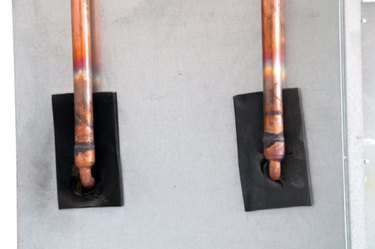Things You'll Need
PVC coupler
PVC reducing bushing
PVC cement
Copper bell reducer
Soldering supplies
Galvanized bell reducer
2 pipe wrenches
Galvanized nipple
Dielectric union
PVC threaded reducing bushing
Copper threaded male adapter
Plumbing tape

It doesn't matter whether your drinking water is drawn from a well or a municipal water supply. The water still travels through pipes of different sizes before reaching your faucet. The transition from water mains, which can be as much as 10 inches in diameter or more, to the pipes supplying your faucet, which typically are half an inch, is done in stages. Looking at each stage of your plumbing, you'll see that a plumber connected pipes of different sizes with a reducing fitting. Reducing fittings vary according to the materials from which the pipes they are connecting are made.
Step 1
Connect PVC water pipes of different sizes with a reducing bushing. It fits inside a coupler glued to the larger pipe and has a hole into which you can insert the smaller one. Choose one that has an outside diameter equal to the diameter of the larger pipe and an inside diameter equal to the diameter of the smaller one.
Video of the Day
Step 2
Glue a coupler to the larger pipe using PVC cement. Spread cement on the outside of the bushing and the inside of the coupler and slide it all the way into the coupler. Spread glue on the inside of the opening and the outside of the smaller pipe, then slide the smaller pipe into the opening.
Step 3
Solder a copper bell reducer onto a pipe and connect it with one of a different diameter by soldering the other pipe to the other end of the reducer. Bell reducers are, as the name implies, shaped like a bell and fit on the outsides of pipes. Like reducing bushings, they are available in various sizes.
Step 4
Use a galvanized bell reducer to connect galvanized steel water pipes of different sizes. Screw one end of the reducer to one of the pipes by holding the pipe with a pipe wrench and screwing on the fitting with another pipe wrench. Connect the other pipe by screwing it onto the other end of the reducer in the same way.
Step 5
Connect a galvanized pipe to a copper one of a different size by screwing a galvanized reducer onto the galvanized pipe and screwing a galvanized nipple, which is a short length of pipe, to the other end. The nipple diameter should be the same as the diameter of the copper pipe you are connecting. Screw a dielectric union onto the other end of the nipple. Solder the copper pipe to the other half of the union and screw the union together with a pipe wrench.
Step 6
Glue a PVC threaded reducing bushing to a plastic pipe to connect it with a copper pipe with a smaller diameter. Solder a threaded male adapter onto the end of the copper pipe. Wrap plumbing tape around the threads and screw it into the bushing.
Tip
Reducing tees are available to branch a smaller diameter pipe off a larger one.
Warning
Always use a dielectric union when connecting copper to steel pipes. It prevents the pipes from touching and creating an electrical charge that will corrode the pipes.
Video of the Day